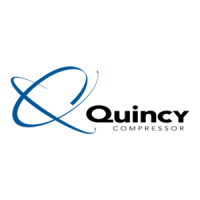.
.
●
✎
✎
✎
✎
✎
✎
●
Inlet filtration should be installed on every pump.
The potential for particulate contamination in-rough
vacuum applications is significant. The particle .
micron retention of the filter element should be
smaller than the smallest possible particle load.
Also, the inlet filter should be mounted in such a
way as to prevent particulate from falling into the
inlet of the vacuum pump during cleaning or
changing of the filter element.
Be sure there is no back pressure on the exhaust line
of the vacuum pump. Vacuum pumps are not
specifically designed to compress exhaust gas above
atmospheric pressure, although they can be adapted .
to do so with some modification. Significant back
pressure can overheat the pump and cause motor
overloading.
When pumping condensable vapors and
particulate, more frequent fluid changes are
.
required to maintain pump life.
Consult factory
about types and styles of filtration units.
Maintain system seals on a regular basis, Torn .
O-ring and gaskets should be replaced immediately.
All flange faces should be free of dirt, lubricant, and
scratches.
Do not use collapsible tubing to plumb the vacuum
system. Any restrictions in line diameter caused by
tube collapse will reduce available pumping
capacity.
In applications where auxiliary exhaust demisters
are used, back pressure in the reservoir should not
exceed 3 psig under normal operating conditions.
Vacuum rated isolation valves should be used for
vacuum applications. Compressed air valves and
vacuum valves differ in their sealing characteristics
and compressed air valves may leak in vacuum
applications.
In multiple pump installations, check valves should
be installed in the inlet piping. This will prevent
fluid from being drawn from an “off” unit into an
operating unit. Check valves should be properly
sized so as not to “chatter” during operation. Spring
loaded, elastomer sealed check valves are
recommended. These should be mounted in a
horizontal flow orientation.
If there is a potential for liquids to be occasionally
drawn into the vacuum system, a receiver can and
should be used to separate these liquids from the
incoming air stream. In applications where there is
significant amounts of liquid, consult the factory.
Vacuum gauge ports and gauges should be installed
in each leg of central vacuum piping. This provides
a diagnostic tool for troubleshooting both the
application and any pump related problems.
Continuous operation from atmospheric pressure to
10” HgV in not recommended for QSVI vacuum
pumps. In this vacuum range, there is not enough
differential pressure to scavenge the separated fluid
from the separator element back to the inlet valve.
This results in high fluid carryover. There are
modifications that can be made to the vacuum pump
to partially alleviate this condition. Please consult
the factory for details. Intermittent operation in this
vacuum range is acceptable.
Any applications involving gases or vapors other
than air should be approved by Quincy prior to
start-up. These gases or vapors can react with the
fluid or materials of construction of the vacuum
pump and cause premature failures.
Any vacuum pump placed in an application with
inlet gas stream temperatures above 120° should be
approved by Quincy prior to start-up.
Quincy QSVI Rotary Screw Vacuum Pumps, with or
without enclosures, are designed for indoor
installation only.
Page 29

